Importance of Information Technology in NHS: Literature Review and Analysis
VerifiedAdded on 2023/04/23
|10
|2946
|260
AI Summary
This report explained the importance of information technology in the NHS organization, ethical and social issues associated with this technology and various kinds of network technologies.
Contribute Materials
Your contribution can guide someone’s learning journey. Share your
documents today.
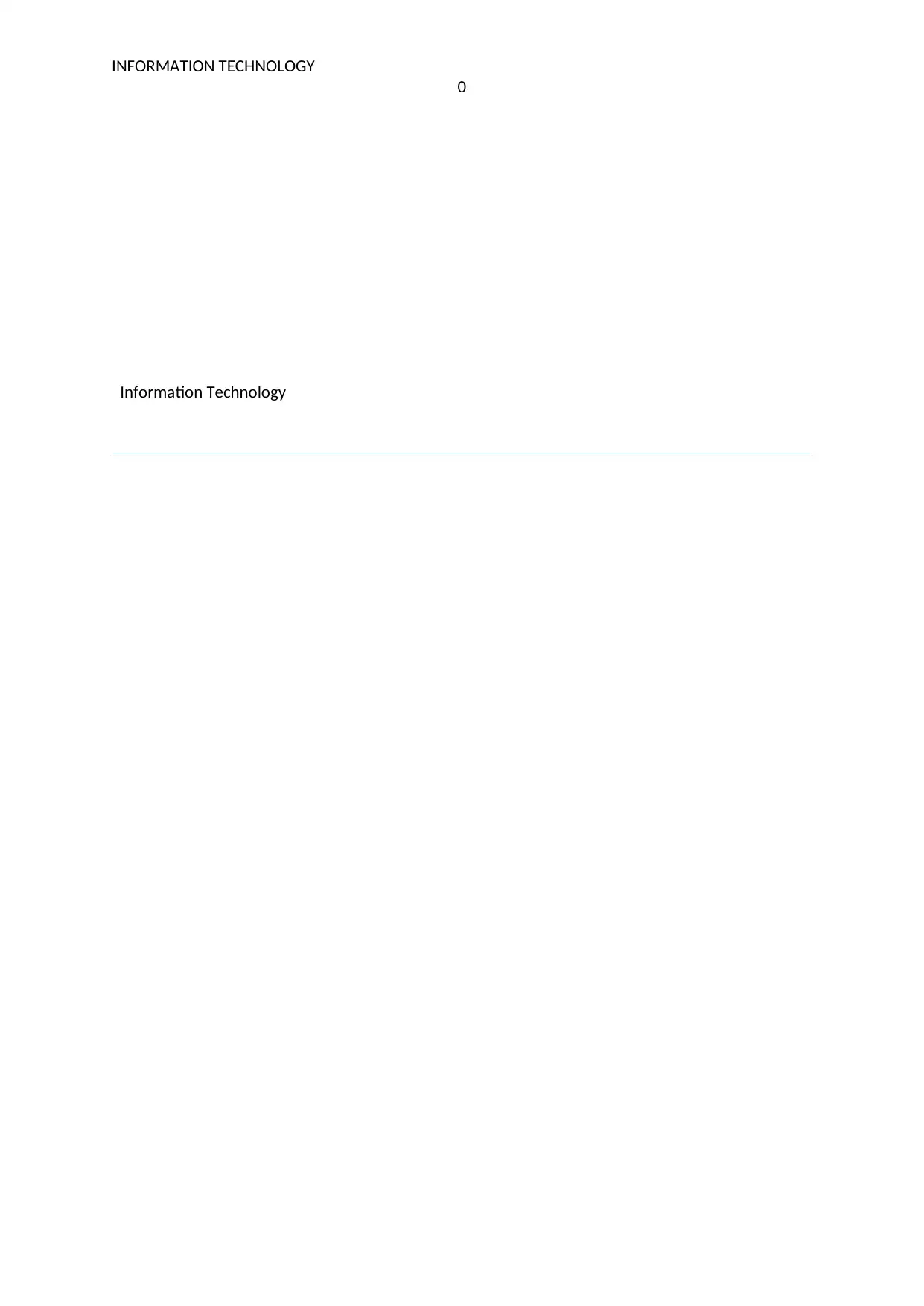
INFORMATION TECHNOLOGY
0
Information Technology
0
Information Technology
Secure Best Marks with AI Grader
Need help grading? Try our AI Grader for instant feedback on your assignments.

INFORMATION TECHNOLOGY
1
Table of Contents
Introduction...........................................................................................................................................2
Literature review...................................................................................................................................2
Analysis and discussion..........................................................................................................................6
Findings.................................................................................................................................................6
Conclusion.............................................................................................................................................7
References.............................................................................................................................................8
1
Table of Contents
Introduction...........................................................................................................................................2
Literature review...................................................................................................................................2
Analysis and discussion..........................................................................................................................6
Findings.................................................................................................................................................6
Conclusion.............................................................................................................................................7
References.............................................................................................................................................8
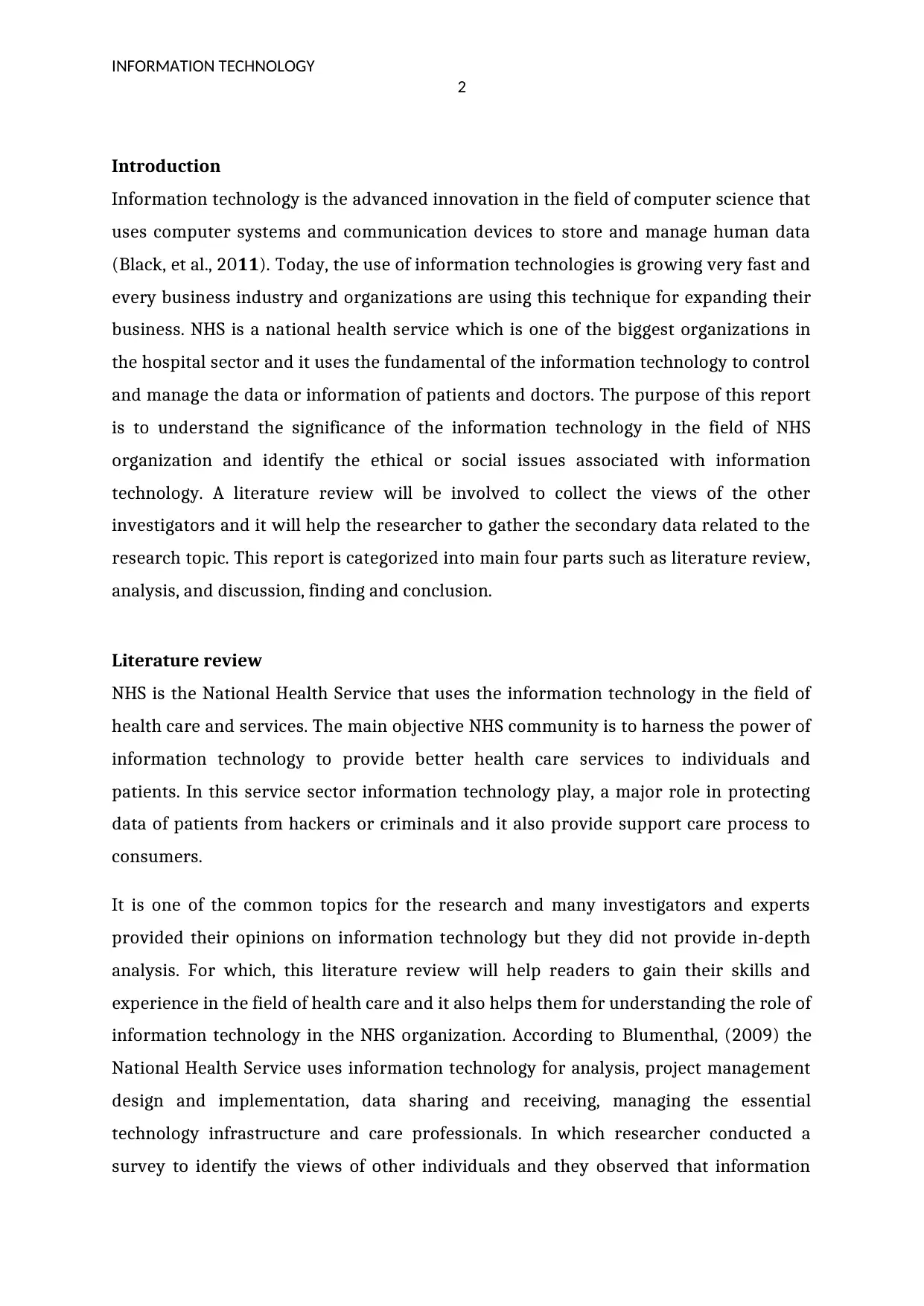
INFORMATION TECHNOLOGY
2
Introduction
Information technology is the advanced innovation in the field of computer science that
uses computer systems and communication devices to store and manage human data
( 11Black, et al., 20 ). Today, the use of information technologies is growing very fast and
every business industry and organizations are using this technique for expanding their
business. NHS is a national health service which is one of the biggest organizations in
the hospital sector and it uses the fundamental of the information technology to control
and manage the data or information of patients and doctors. The purpose of this report
is to understand the significance of the information technology in the field of NHS
organization and identify the ethical or social issues associated with information
technology. A literature review will be involved to collect the views of the other
investigators and it will help the researcher to gather the secondary data related to the
research topic. This report is categorized into main four parts such as literature review,
analysis, and discussion, finding and conclusion.
Literature review
NHS is the National Health Service that uses the information technology in the field of
health care and services. The main objective NHS community is to harness the power of
information technology to provide better health care services to individuals and
patients. In this service sector information technology play, a major role in protecting
data of patients from hackers or criminals and it also provide support care process to
consumers.
It is one of the common topics for the research and many investigators and experts
provided their opinions on information technology but they did not provide in-depth
analysis. For which, this literature review will help readers to gain their skills and
experience in the field of health care and it also helps them for understanding the role of
information technology in the NHS organization. According to Blumenthal, (2009) the
National Health Service uses information technology for analysis, project management
design and implementation, data sharing and receiving, managing the essential
technology infrastructure and care professionals. In which researcher conducted a
survey to identify the views of other individuals and they observed that information
2
Introduction
Information technology is the advanced innovation in the field of computer science that
uses computer systems and communication devices to store and manage human data
( 11Black, et al., 20 ). Today, the use of information technologies is growing very fast and
every business industry and organizations are using this technique for expanding their
business. NHS is a national health service which is one of the biggest organizations in
the hospital sector and it uses the fundamental of the information technology to control
and manage the data or information of patients and doctors. The purpose of this report
is to understand the significance of the information technology in the field of NHS
organization and identify the ethical or social issues associated with information
technology. A literature review will be involved to collect the views of the other
investigators and it will help the researcher to gather the secondary data related to the
research topic. This report is categorized into main four parts such as literature review,
analysis, and discussion, finding and conclusion.
Literature review
NHS is the National Health Service that uses the information technology in the field of
health care and services. The main objective NHS community is to harness the power of
information technology to provide better health care services to individuals and
patients. In this service sector information technology play, a major role in protecting
data of patients from hackers or criminals and it also provide support care process to
consumers.
It is one of the common topics for the research and many investigators and experts
provided their opinions on information technology but they did not provide in-depth
analysis. For which, this literature review will help readers to gain their skills and
experience in the field of health care and it also helps them for understanding the role of
information technology in the NHS organization. According to Blumenthal, (2009) the
National Health Service uses information technology for analysis, project management
design and implementation, data sharing and receiving, managing the essential
technology infrastructure and care professionals. In which researcher conducted a
survey to identify the views of other individuals and they observed that information

INFORMATION TECHNOLOGY
3
technology has the ability to provide the better health care services to consumers and
patients and they can communicate from any location by using networking
technologies. Mainly, national health services use such kind of strategy to provide
health care services to individuals and the data or information is collected through
information technology devices. Buntin 11, et al., (20 ) evaluated that the use of
information technology has increased by the 45% in the NHS community due to their
benefits such as more efficient, very easy to understand and low power consumption
technique. The author conducted a literature review in their investigation and analyzed
that NHS community uses the information technology for collecting and monitoring the
data or information of patients from hackers.
According to Cresswell, and Sheikh, (2009) information technology and networks have
the capability to enhance the quality, security, and performance of health care. It is
observed that diffusion of the information technology in the field of health care is
mainly but recent investigation investigated that providers plan can enhance their
efficiency. The researcher observed that cost and complexity both are the main key
factors that occur the problem in the information technology and NHS reduced their
productivity due to these major elements. 1Cresswell and Sheikh, (20 3) observed that
information technology can increase the productivity of any business and NHS has
succeeded their business in the last three years because of information technology. Such
kind of technology provides a platform to the health care services and their individuals
and patients can access and use health-related information to easily understand their
problems and issues. Moreover, the National Health Services adopted the numbers of
information technologies in their businesses but they are also suffered from the hacking
and data breach related issues in their system. Lack of security and use of information
technology can increase the rate of cyber-crimes and NHS was faced malware and
denial of service attack that affected their business and productivity. The problem of
failure is increased due to data breaches and cyber-attacks and NHS uses internet
connectivity to communicate with their patients which are associated with security
threats.
According to 1Cresswell, Worth, and Sheikh, (20 0) the use of information technology is
completed depending on the setting and institution and the prevalence of the IT
innovation in any setting reflects the strength of the drivers. The researcher also
3
technology has the ability to provide the better health care services to consumers and
patients and they can communicate from any location by using networking
technologies. Mainly, national health services use such kind of strategy to provide
health care services to individuals and the data or information is collected through
information technology devices. Buntin 11, et al., (20 ) evaluated that the use of
information technology has increased by the 45% in the NHS community due to their
benefits such as more efficient, very easy to understand and low power consumption
technique. The author conducted a literature review in their investigation and analyzed
that NHS community uses the information technology for collecting and monitoring the
data or information of patients from hackers.
According to Cresswell, and Sheikh, (2009) information technology and networks have
the capability to enhance the quality, security, and performance of health care. It is
observed that diffusion of the information technology in the field of health care is
mainly but recent investigation investigated that providers plan can enhance their
efficiency. The researcher observed that cost and complexity both are the main key
factors that occur the problem in the information technology and NHS reduced their
productivity due to these major elements. 1Cresswell and Sheikh, (20 3) observed that
information technology can increase the productivity of any business and NHS has
succeeded their business in the last three years because of information technology. Such
kind of technology provides a platform to the health care services and their individuals
and patients can access and use health-related information to easily understand their
problems and issues. Moreover, the National Health Services adopted the numbers of
information technologies in their businesses but they are also suffered from the hacking
and data breach related issues in their system. Lack of security and use of information
technology can increase the rate of cyber-crimes and NHS was faced malware and
denial of service attack that affected their business and productivity. The problem of
failure is increased due to data breaches and cyber-attacks and NHS uses internet
connectivity to communicate with their patients which are associated with security
threats.
According to 1Cresswell, Worth, and Sheikh, (20 0) the use of information technology is
completed depending on the setting and institution and the prevalence of the IT
innovation in any setting reflects the strength of the drivers. The researcher also
Secure Best Marks with AI Grader
Need help grading? Try our AI Grader for instant feedback on your assignments.
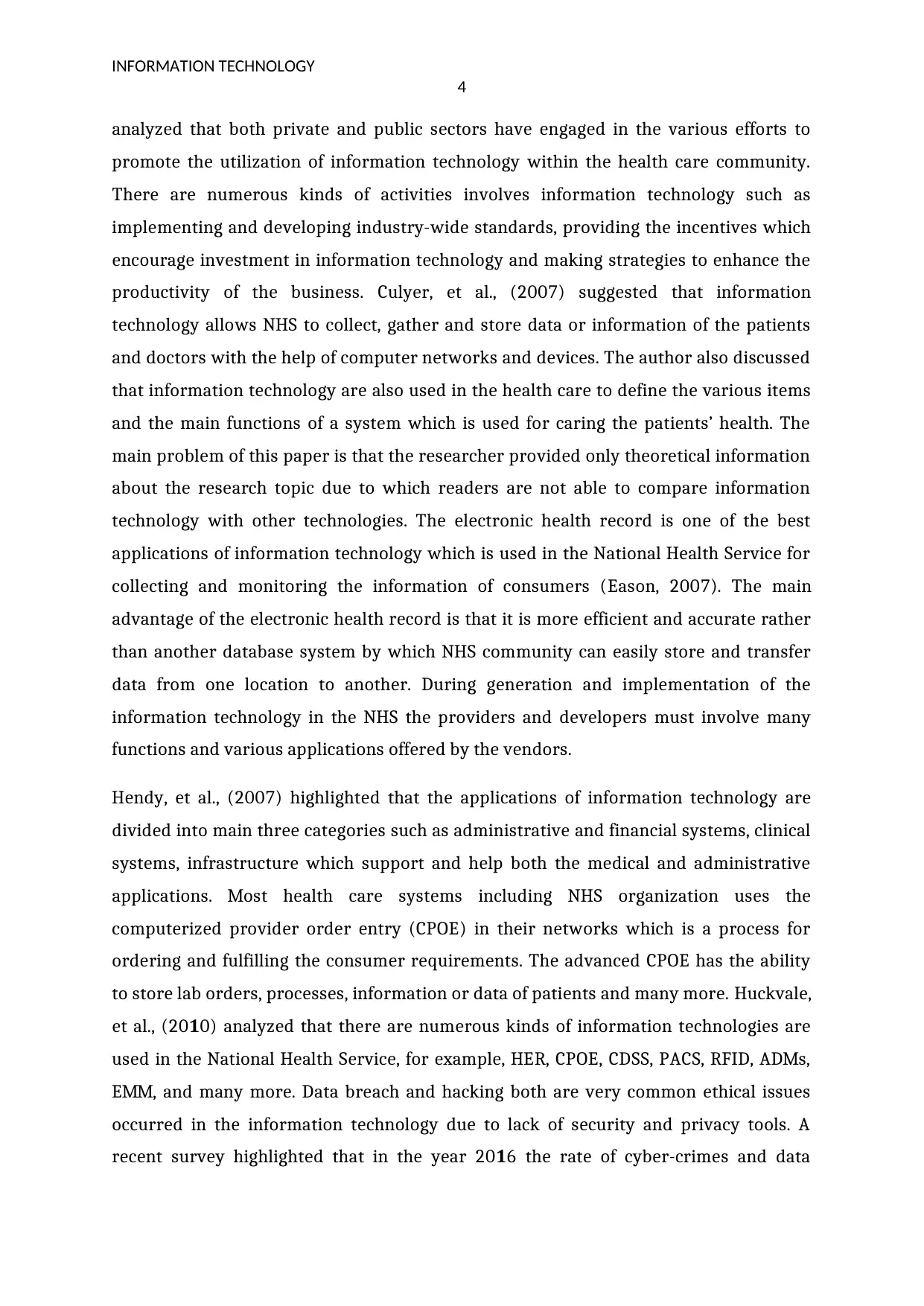
INFORMATION TECHNOLOGY
4
analyzed that both private and public sectors have engaged in the various efforts to
promote the utilization of information technology within the health care community.
There are numerous kinds of activities involves information technology such as
implementing and developing industry-wide standards, providing the incentives which
encourage investment in information technology and making strategies to enhance the
productivity of the business. Culyer, et al., (2007) suggested that information
technology allows NHS to collect, gather and store data or information of the patients
and doctors with the help of computer networks and devices. The author also discussed
that information technology are also used in the health care to define the various items
and the main functions of a system which is used for caring the patients’ health. The
main problem of this paper is that the researcher provided only theoretical information
about the research topic due to which readers are not able to compare information
technology with other technologies. The electronic health record is one of the best
applications of information technology which is used in the National Health Service for
collecting and monitoring the information of consumers (Eason, 2007). The main
advantage of the electronic health record is that it is more efficient and accurate rather
than another database system by which NHS community can easily store and transfer
data from one location to another. During generation and implementation of the
information technology in the NHS the providers and developers must involve many
functions and various applications offered by the vendors.
Hendy, et al., (2007) highlighted that the applications of information technology are
divided into main three categories such as administrative and financial systems, clinical
systems, infrastructure which support and help both the medical and administrative
applications. Most health care systems including NHS organization uses the
computerized provider order entry (CPOE) in their networks which is a process for
ordering and fulfilling the consumer requirements. The advanced CPOE has the ability
to store lab orders, processes, information or data of patients and many more. Huckvale,
1et al., (20 0) analyzed that there are numerous kinds of information technologies are
used in the National Health Service, for example, HER, CPOE, CDSS, PACS, RFID, ADMs,
EMM, and many more. Data breach and hacking both are very common ethical issues
occurred in the information technology due to lack of security and privacy tools. A
1recent survey highlighted that in the year 20 6 the rate of cyber-crimes and data
4
analyzed that both private and public sectors have engaged in the various efforts to
promote the utilization of information technology within the health care community.
There are numerous kinds of activities involves information technology such as
implementing and developing industry-wide standards, providing the incentives which
encourage investment in information technology and making strategies to enhance the
productivity of the business. Culyer, et al., (2007) suggested that information
technology allows NHS to collect, gather and store data or information of the patients
and doctors with the help of computer networks and devices. The author also discussed
that information technology are also used in the health care to define the various items
and the main functions of a system which is used for caring the patients’ health. The
main problem of this paper is that the researcher provided only theoretical information
about the research topic due to which readers are not able to compare information
technology with other technologies. The electronic health record is one of the best
applications of information technology which is used in the National Health Service for
collecting and monitoring the information of consumers (Eason, 2007). The main
advantage of the electronic health record is that it is more efficient and accurate rather
than another database system by which NHS community can easily store and transfer
data from one location to another. During generation and implementation of the
information technology in the NHS the providers and developers must involve many
functions and various applications offered by the vendors.
Hendy, et al., (2007) highlighted that the applications of information technology are
divided into main three categories such as administrative and financial systems, clinical
systems, infrastructure which support and help both the medical and administrative
applications. Most health care systems including NHS organization uses the
computerized provider order entry (CPOE) in their networks which is a process for
ordering and fulfilling the consumer requirements. The advanced CPOE has the ability
to store lab orders, processes, information or data of patients and many more. Huckvale,
1et al., (20 0) analyzed that there are numerous kinds of information technologies are
used in the National Health Service, for example, HER, CPOE, CDSS, PACS, RFID, ADMs,
EMM, and many more. Data breach and hacking both are very common ethical issues
occurred in the information technology due to lack of security and privacy tools. A
1recent survey highlighted that in the year 20 6 the rate of cyber-crimes and data
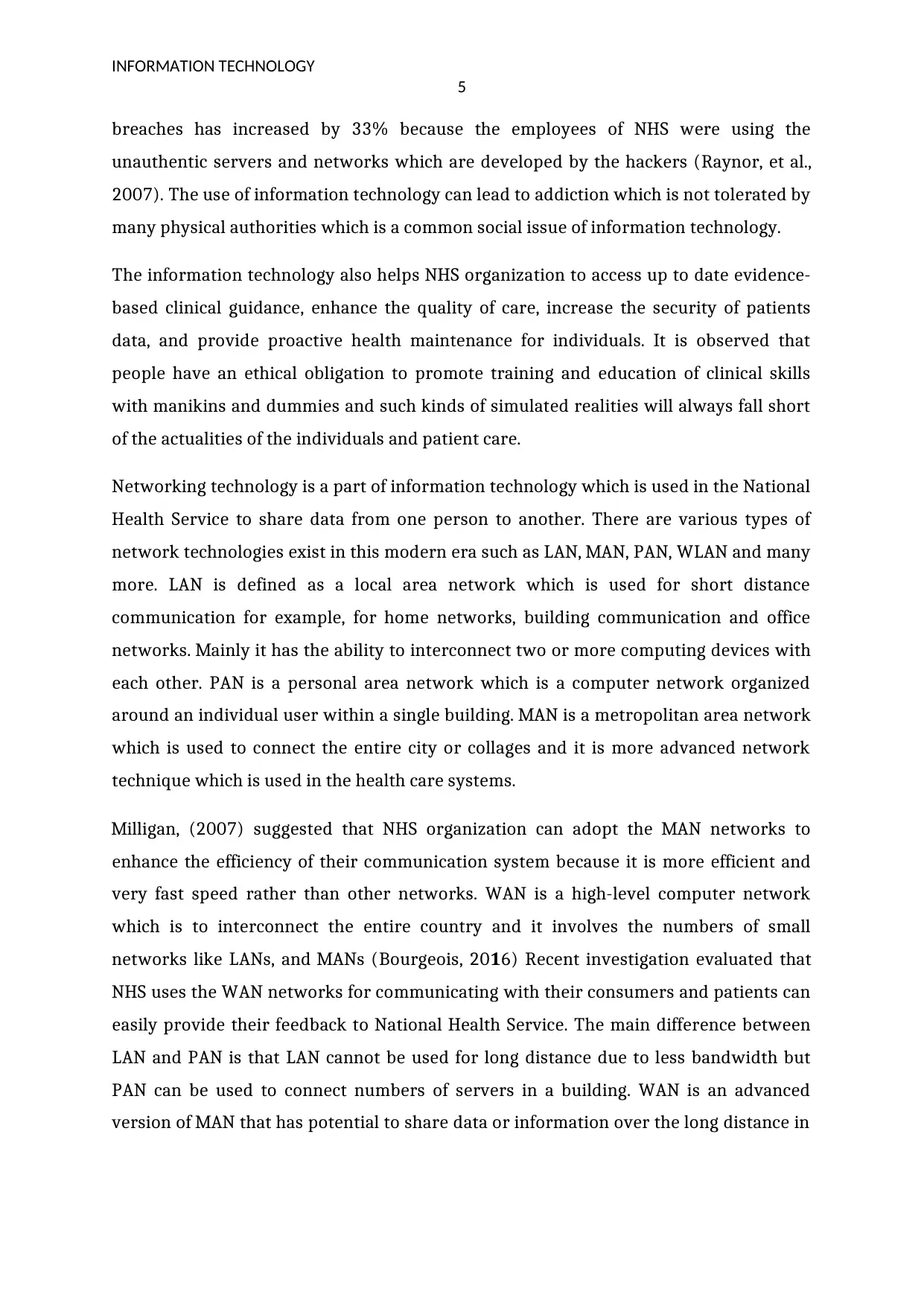
INFORMATION TECHNOLOGY
5
breaches has increased by 33% because the employees of NHS were using the
unauthentic servers and networks which are developed by the hackers (Raynor, et al.,
2007). The use of information technology can lead to addiction which is not tolerated by
many physical authorities which is a common social issue of information technology.
The information technology also helps NHS organization to access up to date evidence-
based clinical guidance, enhance the quality of care, increase the security of patients
data, and provide proactive health maintenance for individuals. It is observed that
people have an ethical obligation to promote training and education of clinical skills
with manikins and dummies and such kinds of simulated realities will always fall short
of the actualities of the individuals and patient care.
Networking technology is a part of information technology which is used in the National
Health Service to share data from one person to another. There are various types of
network technologies exist in this modern era such as LAN, MAN, PAN, WLAN and many
more. LAN is defined as a local area network which is used for short distance
communication for example, for home networks, building communication and office
networks. Mainly it has the ability to interconnect two or more computing devices with
each other. PAN is a personal area network which is a computer network organized
around an individual user within a single building. MAN is a metropolitan area network
which is used to connect the entire city or collages and it is more advanced network
technique which is used in the health care systems.
Milligan, (2007) suggested that NHS organization can adopt the MAN networks to
enhance the efficiency of their communication system because it is more efficient and
very fast speed rather than other networks. WAN is a high-level computer network
which is to interconnect the entire country and it involves the numbers of small
networks like LANs, and MANs ( 1Bourgeois, 20 6) Recent investigation evaluated that
NHS uses the WAN networks for communicating with their consumers and patients can
easily provide their feedback to National Health Service. The main difference between
LAN and PAN is that LAN cannot be used for long distance due to less bandwidth but
PAN can be used to connect numbers of servers in a building. WAN is an advanced
version of MAN that has potential to share data or information over the long distance in
5
breaches has increased by 33% because the employees of NHS were using the
unauthentic servers and networks which are developed by the hackers (Raynor, et al.,
2007). The use of information technology can lead to addiction which is not tolerated by
many physical authorities which is a common social issue of information technology.
The information technology also helps NHS organization to access up to date evidence-
based clinical guidance, enhance the quality of care, increase the security of patients
data, and provide proactive health maintenance for individuals. It is observed that
people have an ethical obligation to promote training and education of clinical skills
with manikins and dummies and such kinds of simulated realities will always fall short
of the actualities of the individuals and patient care.
Networking technology is a part of information technology which is used in the National
Health Service to share data from one person to another. There are various types of
network technologies exist in this modern era such as LAN, MAN, PAN, WLAN and many
more. LAN is defined as a local area network which is used for short distance
communication for example, for home networks, building communication and office
networks. Mainly it has the ability to interconnect two or more computing devices with
each other. PAN is a personal area network which is a computer network organized
around an individual user within a single building. MAN is a metropolitan area network
which is used to connect the entire city or collages and it is more advanced network
technique which is used in the health care systems.
Milligan, (2007) suggested that NHS organization can adopt the MAN networks to
enhance the efficiency of their communication system because it is more efficient and
very fast speed rather than other networks. WAN is a high-level computer network
which is to interconnect the entire country and it involves the numbers of small
networks like LANs, and MANs ( 1Bourgeois, 20 6) Recent investigation evaluated that
NHS uses the WAN networks for communicating with their consumers and patients can
easily provide their feedback to National Health Service. The main difference between
LAN and PAN is that LAN cannot be used for long distance due to less bandwidth but
PAN can be used to connect numbers of servers in a building. WAN is an advanced
version of MAN that has potential to share data or information over the long distance in

INFORMATION TECHNOLOGY
6
very less time. The bandwidth of the LAN is very high as compare to the MAN due to
which the speeds of LAN networks are very large.
Analysis and discussion
From this investigation and previous research on information technology it is analyzed
that information technology plays an important role in the National Health Service for
improving their performance. Above literature review discussed the views of
researchers and other individuals on the research topic and also highlighted the
research gaps in the previous investigation ( 1Waterson, 20 4). It is also analyzed that
the data breach is one of the common ethical issue faced in the information technology
because many users and patients use the third party application and other unwanted
links which are developed and produced by the attackers to collect their personal
information. It is also discussed that electronic health record is completely based on the
information technology which is used by NHS organization to control and manage the
data or information of the patient and it is also used for data sharing a purpose. There
are many network technologies developed by the information technology but WAN and
WLAN both are very important network technologies used in the NHS to communicate
with the patents and individuals.
Findings
It is founded that information technology has the potential to increase the performance
and productivity of NHS businesses and it uses wireless networks, computer devices
1 1and cloud computing in their systems. It is observed that between 20 5 and 20 7 the
rate of information technology in the field of health care has increased by 44% and
many business industries are using this approach for controlling and monitoring the
efficiency of their systems. From this research, it is founded that by using information
technologies consumers can communicate with health care providers from any location
and they can easily maintain their health in very less time. It is also observed that WLAN
is very best computer network which can be used to interconnect numbers of devices in
the NHS organization and the data speed of this network is very high rather than others.
In terms of security, it is very less secure as compare to the WAN and MAN due to which
individuals and companies use the WAN networks for enhancing overall efficiency.
There are many advantages of information technology in the NHS such as a very fast
6
very less time. The bandwidth of the LAN is very high as compare to the MAN due to
which the speeds of LAN networks are very large.
Analysis and discussion
From this investigation and previous research on information technology it is analyzed
that information technology plays an important role in the National Health Service for
improving their performance. Above literature review discussed the views of
researchers and other individuals on the research topic and also highlighted the
research gaps in the previous investigation ( 1Waterson, 20 4). It is also analyzed that
the data breach is one of the common ethical issue faced in the information technology
because many users and patients use the third party application and other unwanted
links which are developed and produced by the attackers to collect their personal
information. It is also discussed that electronic health record is completely based on the
information technology which is used by NHS organization to control and manage the
data or information of the patient and it is also used for data sharing a purpose. There
are many network technologies developed by the information technology but WAN and
WLAN both are very important network technologies used in the NHS to communicate
with the patents and individuals.
Findings
It is founded that information technology has the potential to increase the performance
and productivity of NHS businesses and it uses wireless networks, computer devices
1 1and cloud computing in their systems. It is observed that between 20 5 and 20 7 the
rate of information technology in the field of health care has increased by 44% and
many business industries are using this approach for controlling and monitoring the
efficiency of their systems. From this research, it is founded that by using information
technologies consumers can communicate with health care providers from any location
and they can easily maintain their health in very less time. It is also observed that WLAN
is very best computer network which can be used to interconnect numbers of devices in
the NHS organization and the data speed of this network is very high rather than others.
In terms of security, it is very less secure as compare to the WAN and MAN due to which
individuals and companies use the WAN networks for enhancing overall efficiency.
There are many advantages of information technology in the NHS such as a very fast
Paraphrase This Document
Need a fresh take? Get an instant paraphrase of this document with our AI Paraphraser

INFORMATION TECHNOLOGY
7
process, low cost, easy to understand and implement and reduce security-related
threats. Very complex to design, very difficult to manage the security of patient data,
data can be leaked due to using of unauthentic servers and some patients may not be
able to access their accounts all these are disadvantages of the information technology
in the NHS organization.
Conclusion
It is concluded that the use of information technology in the National Health Service is
one of the best approaches for improving the productivity and success of the business.
This report explained the importance of information technology in the NHS
organization, ethical and social issues associated with this technology and various kinds
of network technologies.
7
process, low cost, easy to understand and implement and reduce security-related
threats. Very complex to design, very difficult to manage the security of patient data,
data can be leaked due to using of unauthentic servers and some patients may not be
able to access their accounts all these are disadvantages of the information technology
in the NHS organization.
Conclusion
It is concluded that the use of information technology in the National Health Service is
one of the best approaches for improving the productivity and success of the business.
This report explained the importance of information technology in the NHS
organization, ethical and social issues associated with this technology and various kinds
of network technologies.
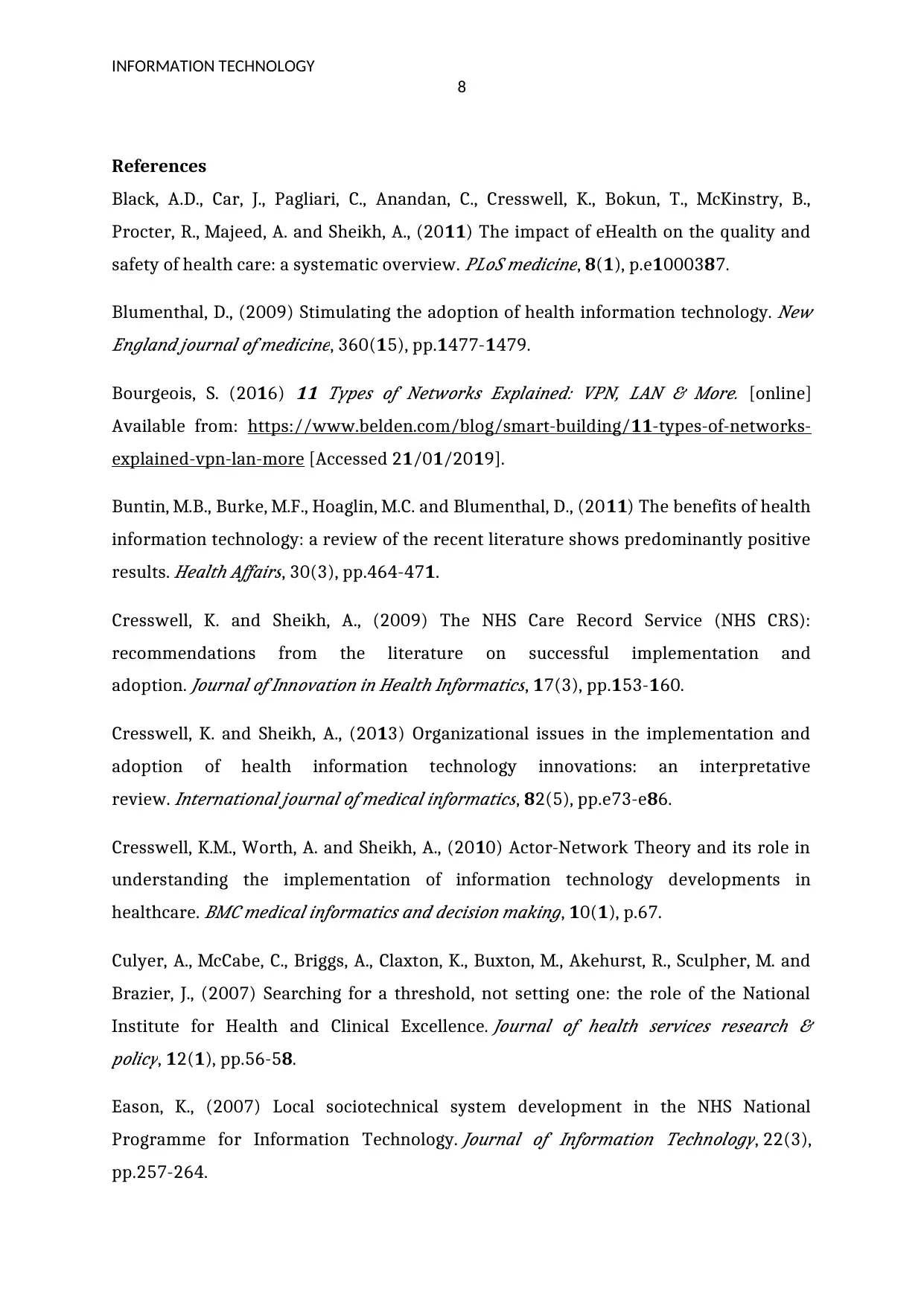
INFORMATION TECHNOLOGY
8
References
Black, A.D., Car, J., Pagliari, C., Anandan, C., Cresswell, K., Bokun, T., McKinstry, B.,
11Procter, R., Majeed, A. and Sheikh, A., (20 ) The impact of eHealth on the quality and
safety of health care: a systematic overview.
PLoS medicine, 8 1 1 8( ), p.e 0003 7.
Blumenthal, D., (2009) Stimulating the adoption of health information technology.
New
England journal of medicine, 360 1 1 1( 5), pp. 477- 479.
1Bourgeois, S. (20 6)
11 Types of Networks Explained: VPN, LAN & More. [online]
Available from: 11https://www.belden.com/blog/smart-building/ -types-of-networks-
explained-vpn-lan-more 1 1 1[Accessed 2 /0 /20 9].
11Buntin, M.B., Burke, M.F., Hoaglin, M.C. and Blumenthal, D., (20 ) The benefits of health
information technology: a review of the recent literature shows predominantly positive
results.
Health Affairs, 30 1(3), pp.464-47 .
Cresswell, K. and Sheikh, A., (2009) The NHS Care Record Service (NHS CRS):
recommendations from the literature on successful implementation and
adoption.
Journal of Innovation in Health Informatics, 17 1 1(3), pp. 53- 60.
1Cresswell, K. and Sheikh, A., (20 3) Organizational issues in the implementation and
adoption of health information technology innovations: an interpretative
review.
International journal of medical informatics, 82 8(5), pp.e73-e 6.
1Cresswell, K.M., Worth, A. and Sheikh, A., (20 0) Actor-Network Theory and its role in
understanding the implementation of information technology developments in
healthcare.
BMC medical informatics and decision making, 10 1( ), p.67.
Culyer, A., McCabe, C., Briggs, A., Claxton, K., Buxton, M., Akehurst, R., Sculpher, M. and
Brazier, J., (2007) Searching for a threshold, not setting one: the role of the National
Institute for Health and Clinical Excellence.
Journal of health services research &
policy, 12 1 8( ), pp.56-5 .
Eason, K., (2007) Local sociotechnical system development in the NHS National
Programme for Information Technology.
Journal of Information Technology, 22(3),
pp.257-264.
8
References
Black, A.D., Car, J., Pagliari, C., Anandan, C., Cresswell, K., Bokun, T., McKinstry, B.,
11Procter, R., Majeed, A. and Sheikh, A., (20 ) The impact of eHealth on the quality and
safety of health care: a systematic overview.
PLoS medicine, 8 1 1 8( ), p.e 0003 7.
Blumenthal, D., (2009) Stimulating the adoption of health information technology.
New
England journal of medicine, 360 1 1 1( 5), pp. 477- 479.
1Bourgeois, S. (20 6)
11 Types of Networks Explained: VPN, LAN & More. [online]
Available from: 11https://www.belden.com/blog/smart-building/ -types-of-networks-
explained-vpn-lan-more 1 1 1[Accessed 2 /0 /20 9].
11Buntin, M.B., Burke, M.F., Hoaglin, M.C. and Blumenthal, D., (20 ) The benefits of health
information technology: a review of the recent literature shows predominantly positive
results.
Health Affairs, 30 1(3), pp.464-47 .
Cresswell, K. and Sheikh, A., (2009) The NHS Care Record Service (NHS CRS):
recommendations from the literature on successful implementation and
adoption.
Journal of Innovation in Health Informatics, 17 1 1(3), pp. 53- 60.
1Cresswell, K. and Sheikh, A., (20 3) Organizational issues in the implementation and
adoption of health information technology innovations: an interpretative
review.
International journal of medical informatics, 82 8(5), pp.e73-e 6.
1Cresswell, K.M., Worth, A. and Sheikh, A., (20 0) Actor-Network Theory and its role in
understanding the implementation of information technology developments in
healthcare.
BMC medical informatics and decision making, 10 1( ), p.67.
Culyer, A., McCabe, C., Briggs, A., Claxton, K., Buxton, M., Akehurst, R., Sculpher, M. and
Brazier, J., (2007) Searching for a threshold, not setting one: the role of the National
Institute for Health and Clinical Excellence.
Journal of health services research &
policy, 12 1 8( ), pp.56-5 .
Eason, K., (2007) Local sociotechnical system development in the NHS National
Programme for Information Technology.
Journal of Information Technology, 22(3),
pp.257-264.
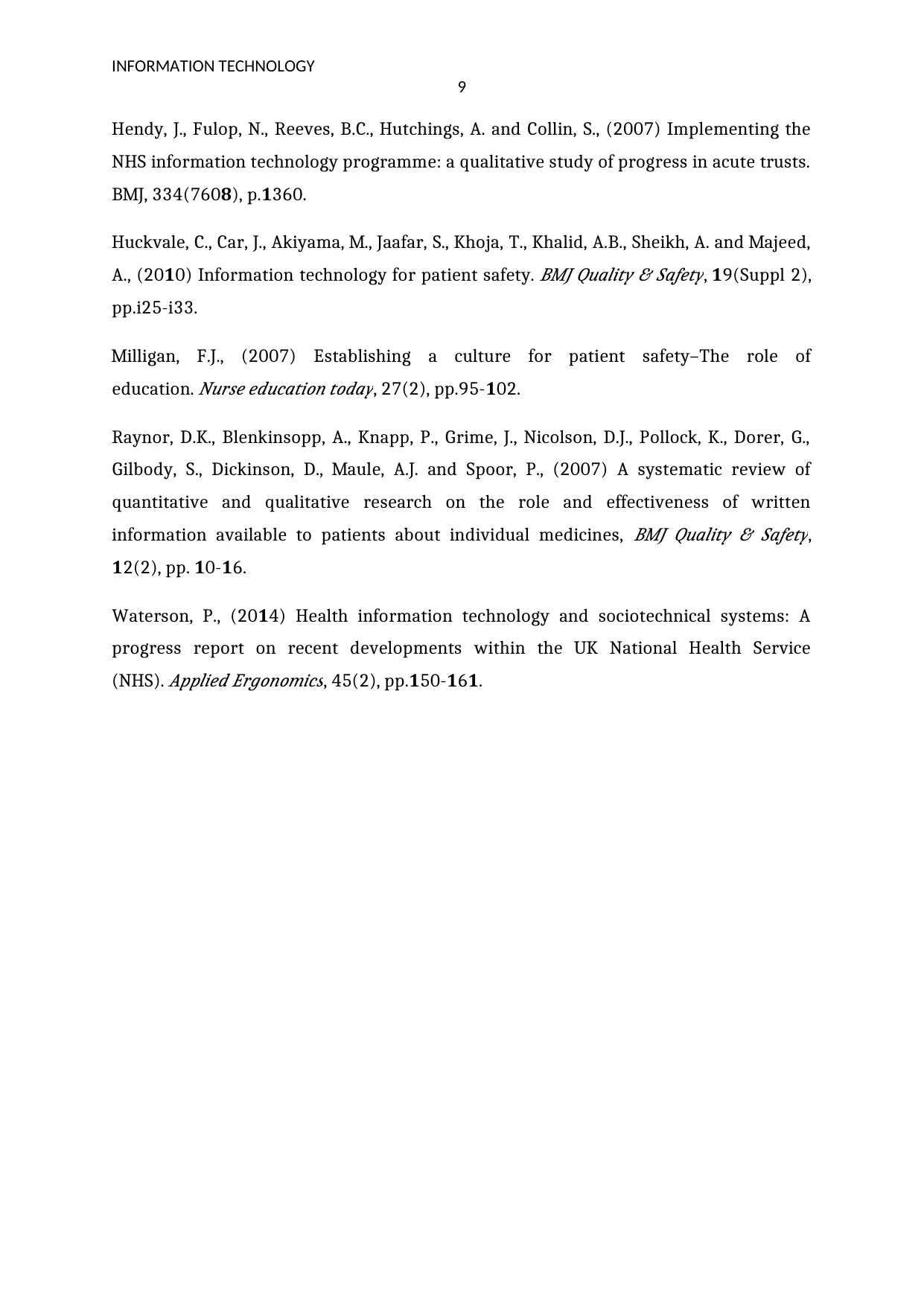
INFORMATION TECHNOLOGY
9
Hendy, J., Fulop, N., Reeves, B.C., Hutchings, A. and Collin, S., (2007) Implementing the
NHS information technology programme: a qualitative study of progress in acute trusts.
BMJ, 334 8 1(760 ), p. 360.
Huckvale, C., Car, J., Akiyama, M., Jaafar, S., Khoja, T., Khalid, A.B., Sheikh, A. and Majeed,
1A., (20 0) Information technology for patient safety.
BMJ Quality & Safety, 19(Suppl 2),
pp.i25-i33.
Milligan, F.J., (2007) Establishing a culture for patient safety–The role of
education.
Nurse education today, 27 1(2), pp.95- 02.
Raynor, D.K., Blenkinsopp, A., Knapp, P., Grime, J., Nicolson, D.J., Pollock, K., Dorer, G.,
Gilbody, S., Dickinson, D., Maule, A.J. and Spoor, P., (2007) A systematic review of
quantitative and qualitative research on the role and effectiveness of written
information available to patients about individual medicines,
BMJ Quality & Safety,
1 1 12(2), pp. 0- 6.
1Waterson, P., (20 4) Health information technology and sociotechnical systems: A
progress report on recent developments within the UK National Health Service
(NHS).
Applied Ergonomics, 45 1 1 1(2), pp. 50- 6 .
9
Hendy, J., Fulop, N., Reeves, B.C., Hutchings, A. and Collin, S., (2007) Implementing the
NHS information technology programme: a qualitative study of progress in acute trusts.
BMJ, 334 8 1(760 ), p. 360.
Huckvale, C., Car, J., Akiyama, M., Jaafar, S., Khoja, T., Khalid, A.B., Sheikh, A. and Majeed,
1A., (20 0) Information technology for patient safety.
BMJ Quality & Safety, 19(Suppl 2),
pp.i25-i33.
Milligan, F.J., (2007) Establishing a culture for patient safety–The role of
education.
Nurse education today, 27 1(2), pp.95- 02.
Raynor, D.K., Blenkinsopp, A., Knapp, P., Grime, J., Nicolson, D.J., Pollock, K., Dorer, G.,
Gilbody, S., Dickinson, D., Maule, A.J. and Spoor, P., (2007) A systematic review of
quantitative and qualitative research on the role and effectiveness of written
information available to patients about individual medicines,
BMJ Quality & Safety,
1 1 12(2), pp. 0- 6.
1Waterson, P., (20 4) Health information technology and sociotechnical systems: A
progress report on recent developments within the UK National Health Service
(NHS).
Applied Ergonomics, 45 1 1 1(2), pp. 50- 6 .
1 out of 10
Related Documents
Your All-in-One AI-Powered Toolkit for Academic Success.
+13062052269
info@desklib.com
Available 24*7 on WhatsApp / Email
![[object Object]](/_next/static/media/star-bottom.7253800d.svg)
Unlock your academic potential
© 2024 | Zucol Services PVT LTD | All rights reserved.




